
Barbara Kruger (b. 1945) has redefined contemporary art through her incisive blend of found imagery and provocative text. Over more than four decades, her work has interrogated the constructs of power, consumer culture, and identity.
Barbara Kruger was born in Newark, New Jersey, in 1945 and raised in a working-class environment that instilled in her an acute awareness of socioeconomic hierarchies and racial dynamics. Her formative years were marked by the contrasting influences of a modest upbringing and the burgeoning world of commercial media. After a brief period at Syracuse University, Kruger moved to New York City to refine her artistic vision at the Parsons School of Design. Here, under the tutelage of figures such as photographer Diane Arbus and graphic designer Marvin Israel, she absorbed both technical skills and a critical approach to visual culture.
Her early career as a graphic designer and picture editor at Condé Nast Publications and Mademoiselle magazine provided her with essential training in layout, typography, and visual rhetoric. This period was transformative; the rigorous demands of commercial design honed her eye for composition and narrative, laying the groundwork for her later, more politically charged work. Kruger’s exposure to the language of advertising and the aesthetics of mass media not only influenced her stylistic choices but also planted the seeds for her later critique of consumerism and cultural power structures.

Her early artistic endeavors also included experiments in weaving, painting, and textile work during the late 1960s and early 1970s. These initial explorations, though later set aside, reflect an engagement with craft and the handmade; a contrast to the slick, impersonal imagery of commercial advertising that would become her signature. Teaching positions at institutions such as the University of California, Berkeley during the mid-1970s further expanded her intellectual horizons and deepened her interest in critical theory and the politics of representation.Tate describes how Kruger’s early experiences in graphic design “became, with a few adjustments, her ‘work’ as an artist” (Tate). This fusion of commercial skill and radical critique is central to understanding her evolution as an artist.
Kruger’s art is quintessentially conceptual, its power lies not in traditional aesthetics but in the ideas it communicates. Central to her practice is the appropriation of mass-media images, which she transforms by overlaying them with terse, confrontational phrases. Using fonts such as Futura Bold Oblique or Helvetica Ultra Condensed, her text is rendered in bold white against a stark red background (or in red or black against contrasting fields). This visual formula is designed to arrest the viewer’s attention and provoke critical reflection.
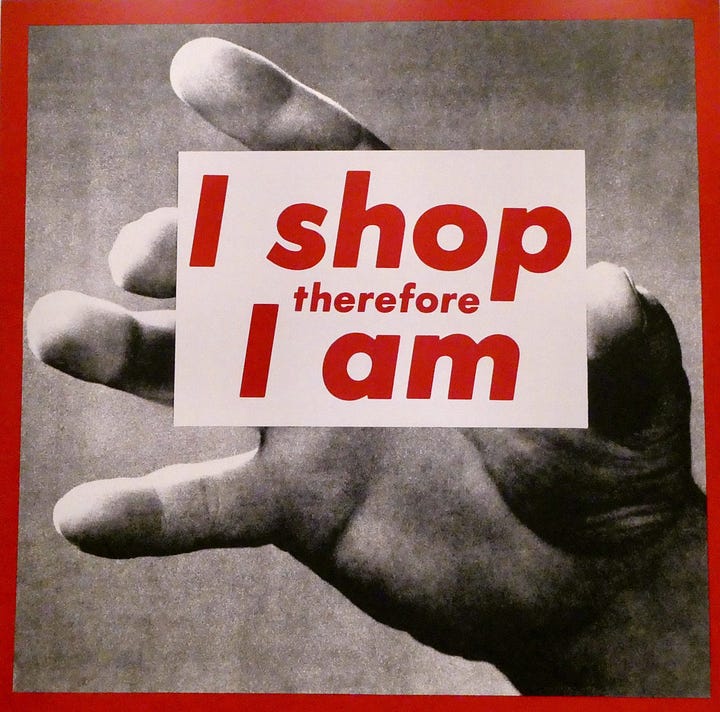
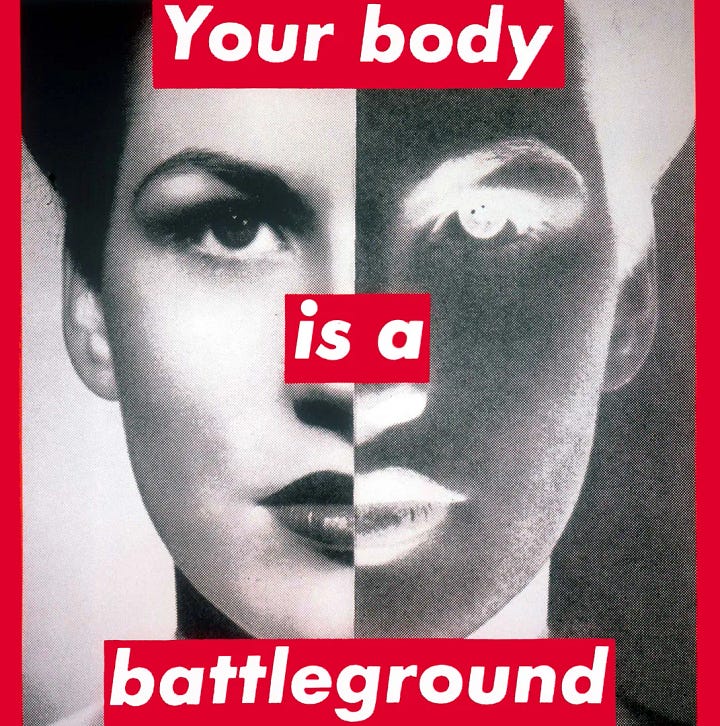
Her slogans, phrases like “I shop therefore I am” and “Your body is a battleground”, are not mere decorative elements but incisive critiques of contemporary life. They challenge the viewer to reconsider familiar cultural narratives. Kruger has stated, “I work with pictures and words because they have the ability to determine who we are and who we aren’t” (MoMA). By juxtaposing text and imagery drawn from everyday media, she deconstructs the persuasive language of advertising and exposes the ideologies that underpin consumer culture, gender roles, and social hierarchies.
Technically, Kruger’s process involves digital manipulation as well as traditional screen-printing techniques. In her early “paste-up” works (1978–1982), she hand-cut images from magazines and reassembled them with her own textual interventions. As her practice matured, she embraced larger-scale productions and public installations, adapting her visual rhetoric for environments as diverse as billboards, buses, and museum walls. According to Smithsonian American Art Museum, her method “repurposes the visual tropes of advertising to interrogate the power relations inherent in everyday life” (Smithsonian American Art Museum).
This technique of blending text and image has cemented her reputation as a visual critic who not only challenges dominant cultural narratives but also invites viewers to become active participants in the act of interpretation.
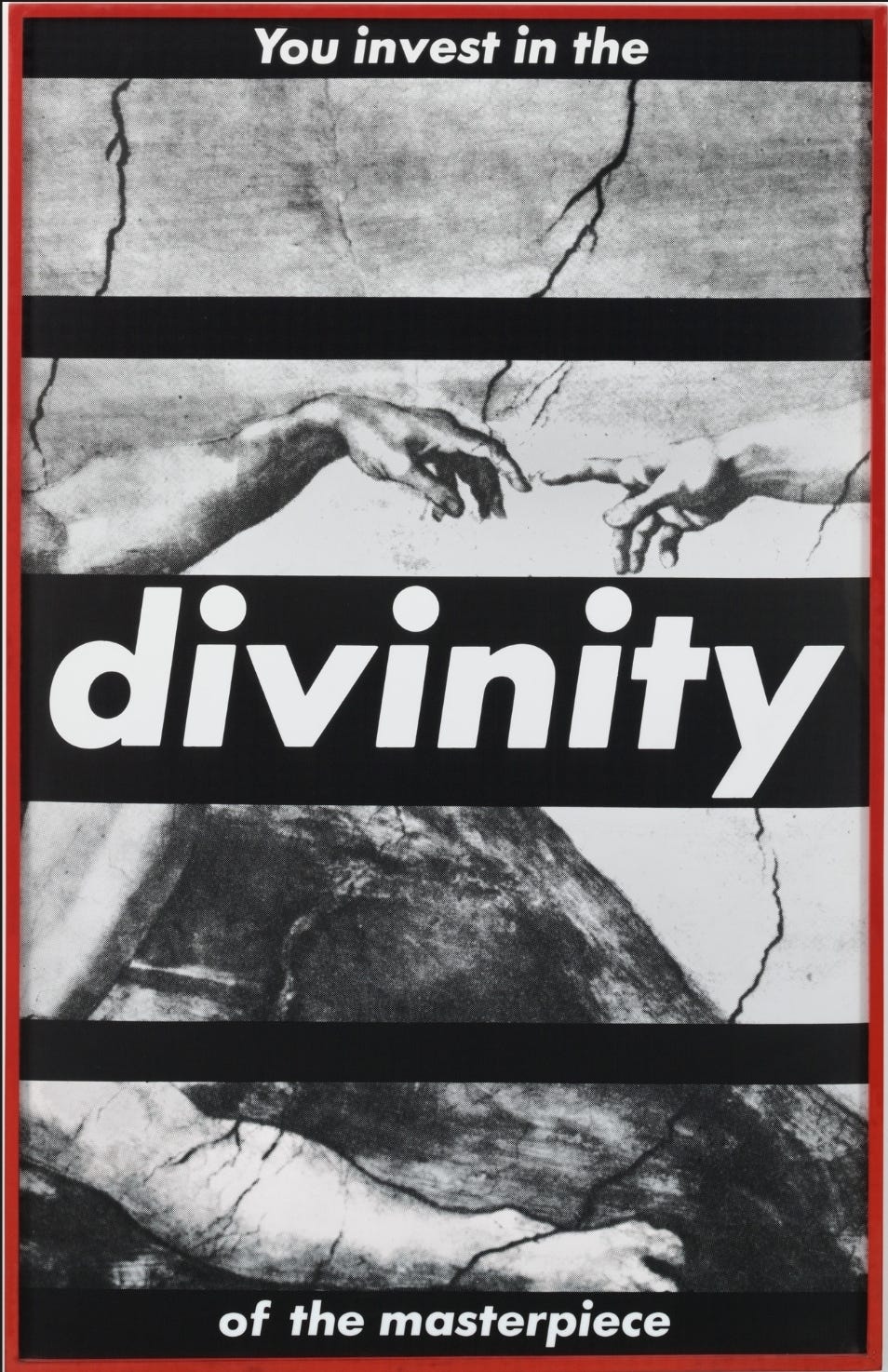
A cornerstone of Kruger’s oeuvre is her ability to distill complex social and political issues into concise visual statements. One of her most iconic works, Untitled (Your Body is a Battleground) (1989), was created in the wake of escalating debates over reproductive rights in the United States. The work features a split black-and-white portrait of a woman’s face, one side rendered in positive, the other in negative, with the titular slogan boldly imposed. This duality symbolizes both the internal conflict faced by women and the broader societal battle over bodily autonomy. MoMA notes that this piece “directly implicates the viewer in the struggle for power over the female body” (MoMA).
Another seminal work, I Shop Therefore I Am (1987), subverts René Descartes’ philosophical dictum by suggesting that in contemporary consumer society, identity is defined by consumption rather than thought. The work’s visual simplicity, a stark black-and-white image enclosed in a red frame with the provocative slogan, belies its deep critical engagement with the values of capitalism. Exhibited in major retrospectives at institutions such as the Museum of Contemporary Art, Los Angeles, and the Whitney Museum of American Art, these works have become cultural touchstones that resonate with both art critics and the public.
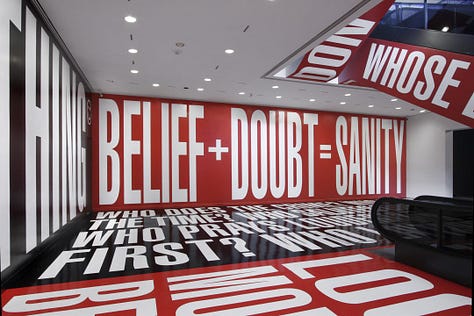
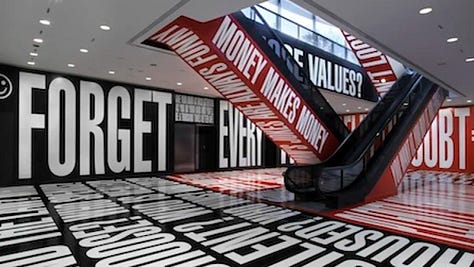
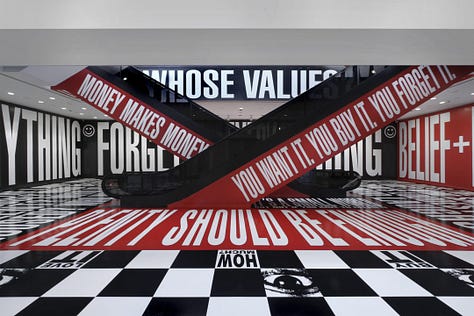

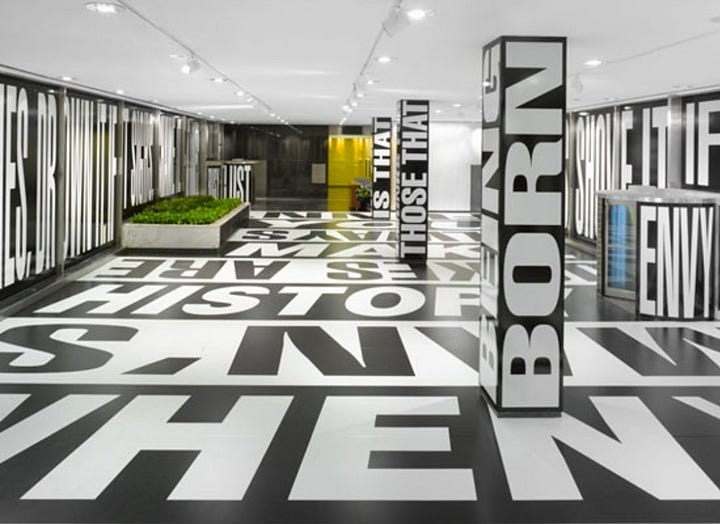
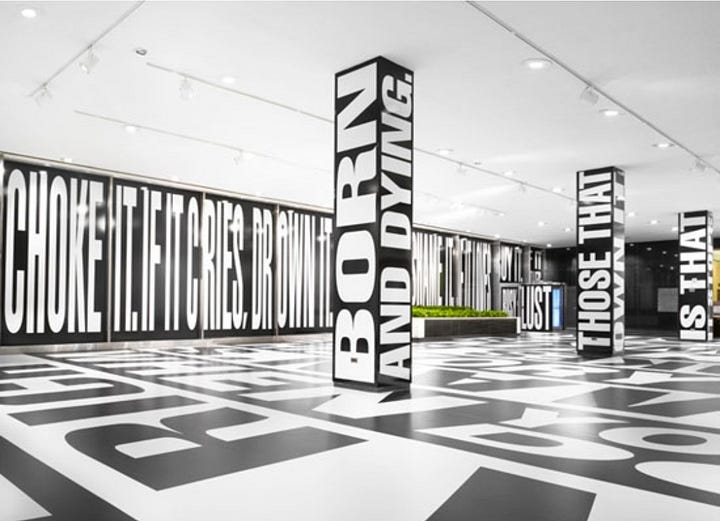
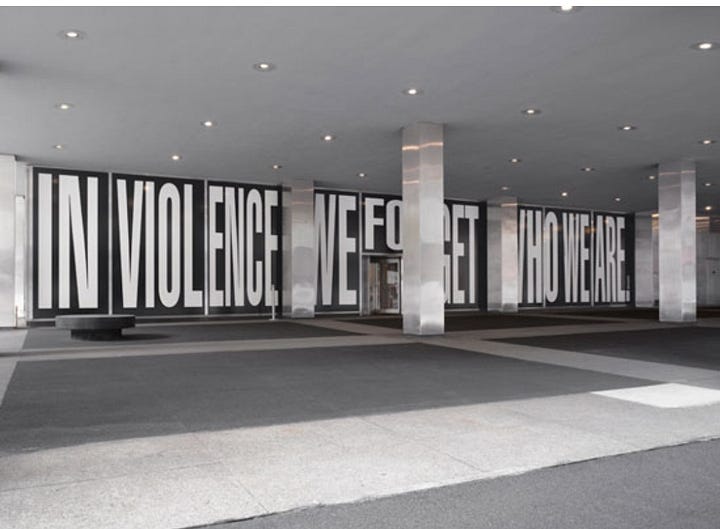
Kruger’s installations extend her critique into physical space. Her large-scale public interventions, including billboards and bus wraps, democratize her art by taking it outside the confines of the gallery. For example, her installation Belief+Doubt at the Hirshhorn Museum and Sculpture Garden transformed a public lobby into a site of interrogation about the interplay of conviction and skepticism in political discourse. The immersive nature of these installations forces viewers to confront the ubiquity of media messages and question the narratives that structure their everyday lives.
Exhibitions of Kruger’s work have been held worldwide; from solo shows at Mary Boone Gallery in New York and Moderna Museet in Stockholm to participation in the Venice Biennale and Documenta in Kassel. Her global reach and the public accessibility of her work underscore its relevance across diverse cultural contexts. As The Art Story explains, “Kruger’s visual language is instantly recognizable and continues to influence contemporary discourse on power, identity, and representation” (The Art Story).
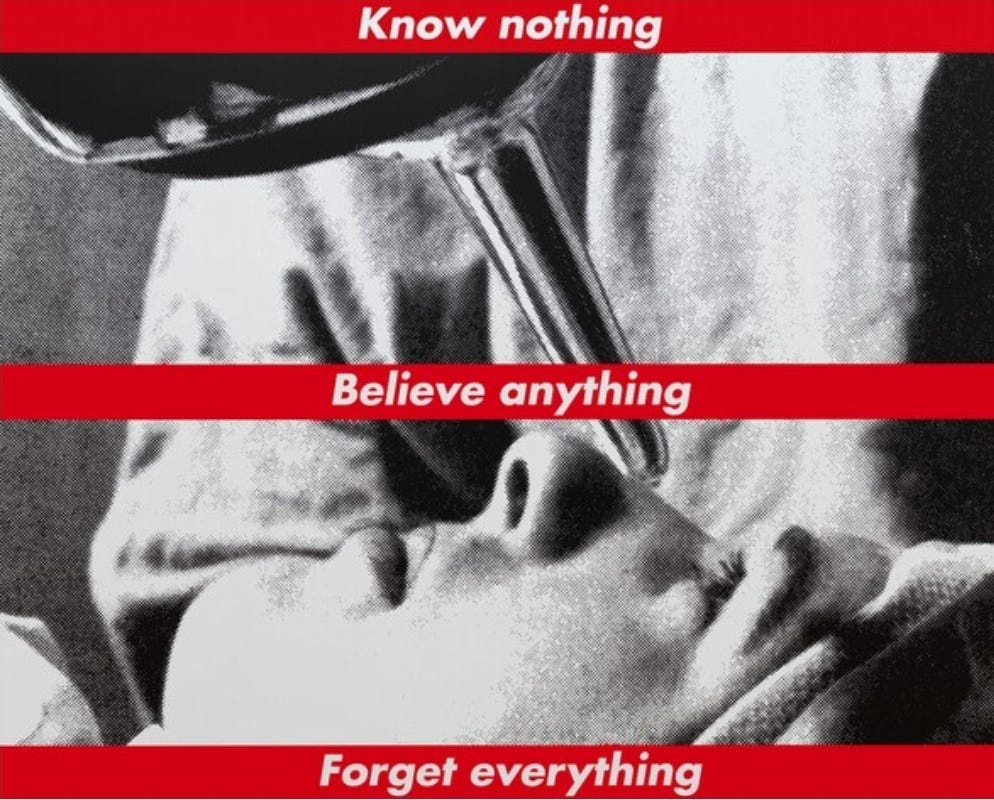
From its inception, Kruger’s work has generated both acclaim and controversy. Critics praise her for harnessing the visual language of consumer culture to dismantle the ideologies that underpin mass media and capitalist structures. Her art is frequently discussed in the context of feminist theory and postmodern critique, resonating with the work of theorists like Foucault, Baudrillard, and Bourdieu. As noted by scholars at Smithsonian American Art Museum, her interventions “create a space where the viewer is forced to reckon with the inherent contradictions of modern society” (Smithsonian American Art Museum).
The directness of Kruger’s style has earned her a reputation as a provocateur. Her bold text and stark imagery challenge viewers to examine their complicity in systems that commodify identity and perpetuate inequality. However, some critics have questioned whether her work, rooted in the aesthetics of advertising, risks becoming formulaic. Yet, the enduring popularity and repeated exhibitions of her work suggest that her ability to merge form and function continues to captivate audiences worldwide.
Kruger’s influence extends beyond the art world. Her visual motifs have permeated popular culture, inspiring everything from fashion designs to political campaigns. Artists such as Jenny Holzer, Cindy Sherman, and Shepard Fairey have drawn on similar techniques, ensuring that her critical vocabulary remains a potent tool in the broader cultural conversation. Tate remarks that Kruger “has not only defined a style but also a mode of critique that continues to inspire new generations of artists and activists” (Tate).
In today’s digital age, where images and words are omnipresent and often ephemeral, Barbara Kruger’s work retains a vital sense of urgency. With the rise of social media and the rapid dissemination of visual content, her critique of the commodification of identity and the manipulation of language has never been more pertinent. Her work challenges viewers to pause and consider not just what they consume, but how and why they consume it.
Kruger’s public installations and digital reinterpretations of her earlier works ensure that her art remains accessible and resonant. As consumer culture evolves and new technologies reshape communication, her insistence on questioning the prevailing narratives serves as a counterpoint to the passive consumption of information. The platforms that once heralded the power of advertising are now sites of critique, as Kruger’s imagery and text continue to provoke discussions about authenticity, representation, and the nature of power.
Her legacy is cemented not only in the visual lexicon of contemporary art but also in the ongoing debates about cultural authority and the role of art as social commentary. Institutions like the Museum of Modern Art, the Smithsonian American Art Museum, and Tate continue to display her work, ensuring that her incisive message endures amid changing cultural landscapes.
Barbara Kruger’s art is a testament to the enduring power of language and imagery as instruments of critique. By repurposing the visual language of advertising, she has created a body of work that is both immediately accessible and profoundly challenging. Her early experiences in graphic design and her evolution into a conceptual artist have equipped her with a unique perspective on the intersection of media, power, and identity. Through iconic works such as I Shop Therefore I Am and Your Body is a Battleground, Kruger has not only interrogated the structures of consumerism and gender politics but has also inspired generations to question the narratives that define their lives.
As contemporary society grapples with the implications of digital media and the saturation of visual culture, Kruger’s work remains an essential call to critical reflection; a reminder that the messages we consume shape not only our perceptions but also our very identities. Her legacy, widely celebrated in global exhibitions and academic discourse alike, continues to influence both art and cultural criticism, affirming that even in a rapidly changing world, the power of a well-chosen word and image endures.
References:
Barbara Kruger. Tate, tate.org.uk/art/artists/barbara-kruger-1443. Accessed 20 Jan. 2025.
Barbara Kruger. MoMA, www.moma.org/artists/3266-barbara-kruger. Accessed 20 Jan. 2025.
Barbara Kruger. Smithsonian American Art Museum, americanart.si.edu/artist/barbara-kruger-2727. Accessed 20 Jan. 2025.
The Art Story: Barbara Kruger. The Art Story, theartstory.org/artist/kruger-barbara/. Accessed 20 Jan. 2025.




Absolutely love this. A super critical analysis!
Thanks for sharing